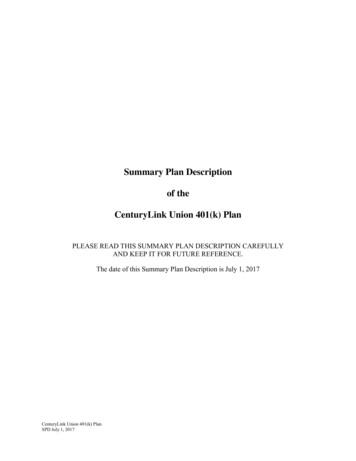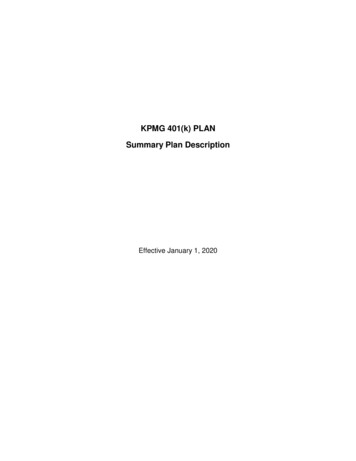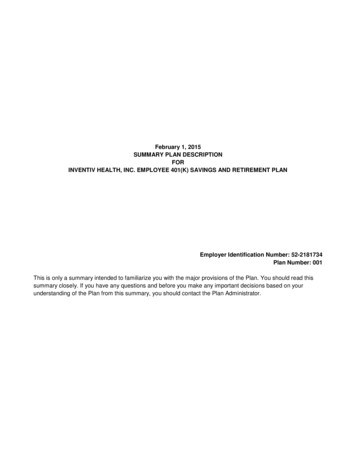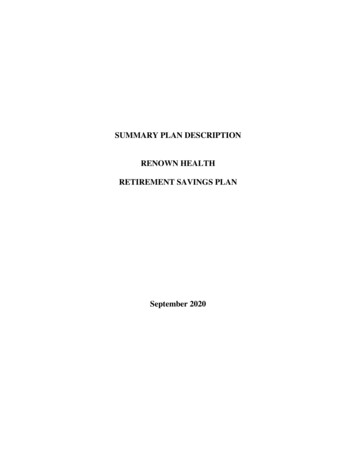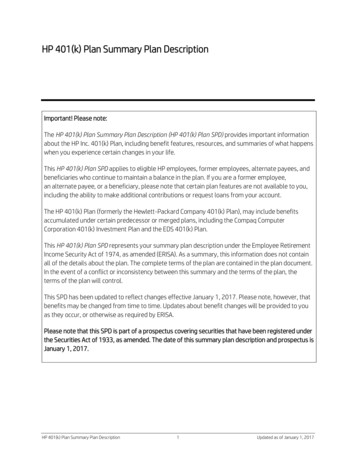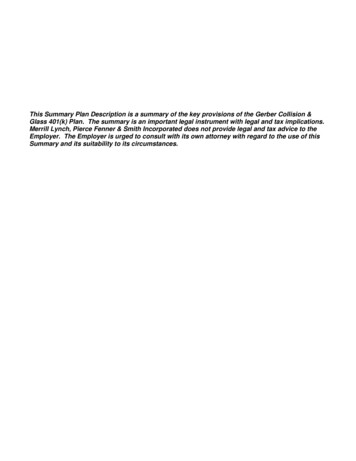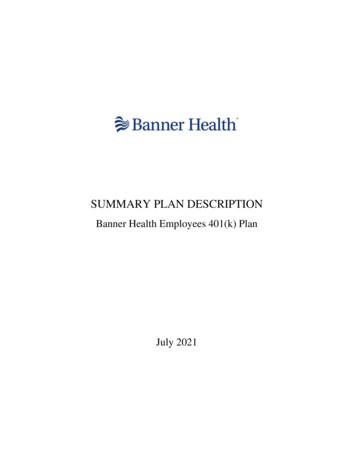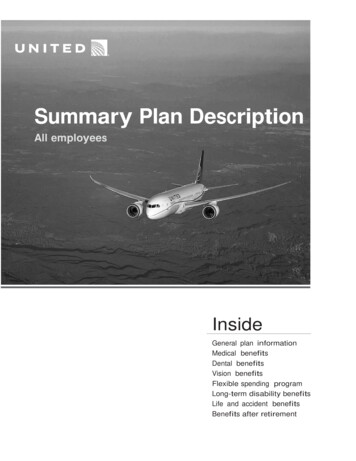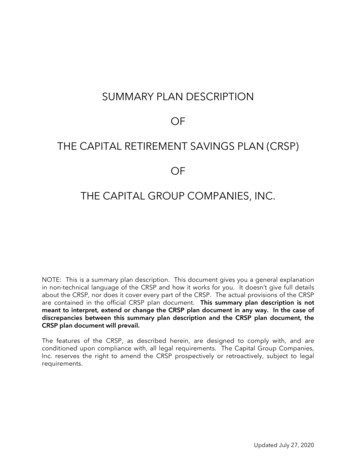
Transcription
SUMMARY PLAN DESCRIPTIONOFTHE CAPITAL RETIREMENT SAVINGS PLAN (CRSP)OFTHE CAPITAL GROUP COMPANIES, INC.NOTE: This is a summary plan description. This document gives you a general explanationin non-technical language of the CRSP and how it works for you. It doesn’t give full detailsabout the CRSP, nor does it cover every part of the CRSP. The actual provisions of the CRSPare contained in the official CRSP plan document. This summary plan description is notmeant to interpret, extend or change the CRSP plan document in any way. In the case ofdiscrepancies between this summary plan description and the CRSP plan document, theCRSP plan document will prevail.The features of the CRSP, as described herein, are designed to comply with, and areconditioned upon compliance with, all legal requirements. The Capital Group Companies,Inc. reserves the right to amend the CRSP prospectively or retroactively, subject to legalrequirements.Updated July 27, 2020
Table of ContentsINTRODUCTION . 1BASIC PLAN INFORMATION . 1PARTICIPATION IN THE PLAN. 21.Who can become a Participant in the Plan? . 22.When do I become a Participant? . 2401(k) CONTRIBUTIONS TO THE PLAN . 23.What type of elective deferrals can be made to the Plan?. 24.What’s the difference between pre-tax deferrals and Roth 401(k)deferrals? . 25.When can I make deferral contributions to the Plan?. 36.How much can I contribute to the Plan?. 37.Can I make Catch-up Contributions? . 48.How often can I change my rate of contribution? . 49.Will a change in employment affect my deferral rights? . 410.Does the Plan provide matching contributions? . 411.What happens if I return to work after a qualified military leave? . 5COMPANY CONTRIBUTIONS TO THE PLAN . 512.How much does the Company contribute to the Plan? . 513.Will all Participants receive a Company contribution every year? . 514.How is my Compensation determined? . 515.Are there any other limitations on the amount of contributions theCompany can make? . 5ROLLOVER CONTRIBUTION ACCOUNTS IN THE PLAN . 516.May I make Rollover Contributions to the Plan? . 517.May I withdraw my Rollover Account at any time? . 6IN-PLAN ROTH ROLLOVER ACCOUNTS IN THE PLAN .618.May I make an In-Plan Roth Rollover Contribution to the Plan?.619.May I withdraw my In Plan Roth Rollover Contribution Account?.6SERVICE AND VESTING OF ACCOUNTS . 720.What is Service? . 721.Will a change in employment affect my status in the Plan? . 722.How does my Service determine Vesting? . 823.Are there other circumstances that affect Vesting? . 8i
24.25.26.27.What happens if I terminate my employment with the Company beforeage 60 for a reason other than death or disability, but before becoming100% vested? . 8What happens if I am re-employed after forfeiting a portion of myAccount? . 8What happens to my participation in the Plan if I return to work after aqualified military leave? . 9What happens if I become mentally or physically disabled?. 9THE PLAN’S INVESTMENT OPTIONS . 928.How are the contributions held and invested? . 929.Who is responsible for investing the contributions? . 930.Can I change my investment selections? .1031.How do changes in market values of the investments affect myAccount? .10IN-SERVICE DISTRIBUTIONS .1032.May I withdraw money while I’m still employed? .1033.Are hardship withdrawals available while I’m still employed? .1034.Do Roth after-tax contributions have any in-service withdrawalrestrictions?.1135.May I borrow money from the Plan? .1136.What are the loan rules and requirements? .11RETIREMENT DISTRIBUTIONS .1237.May I receive a distribution after retirement, disability or termination ofemployment?.1238.In what form will I receive my distribution? .1239.What special rules apply to a Small Account? .1340.May I roll over my distributions? .1341Is the Roth portion of my Account eligible for rollover? .1342.Are distributions from the Plan taxable? .1343.What is a Roth “qualified” distribution? .1344.What if I take a distribution that isn’t “qualified”? .1345.What happens if I become mentally or physically disabled?.1446.What happens if I terminate my employment for a reason other thandeath, disability or retirement? .1447.Can I postpone taking distributions from the Plan after I retire and leavethe Company? .1448.What do I need to do to receive my Account? .14AUTOMATIC ROLLOVERS .1449.What is an Automatic Rollover Account? .1450.What is the automatic rollover rule? .1451.How will the automatic rollover be invested?.1452.When must I provide instructions to have the distribution paid to me orto another plan or IRA? .15ii
53.54.55.56.What are the fees for the automatic rollover IRA? .15Who is the custodian of the automatic rollover IRA? .15Will the beneficiaries I named for the Plan be the beneficiaries of theautomatic rollover IRA? .15How can I get more information about this process? .15BENEFITS UPON DEATH .1557.How do I designate my beneficiary? .1558.Who may be designated as my beneficiary? .1659.What happens if I die without a beneficiary? .1660.How will my Account be paid if my Spouse is my beneficiary? .1661.How will my Account be paid to my non-spouse beneficiary? .17PREDECESSOR PLANS .1762.Is the CRSP the same as the Master Retirement Plan (MRP) and the401(k) Tax Advantage Plan? .17PROTECTION OF YOUR ACCOUNT .1863.Can the Company amend or terminate the Plan?.1864.What would happen if the Plan were to be terminated?.1865.Can my Account be attached or pledged? What happens if I getdivorced or legally separated? .1866.Are there any conditions under which my benefits can decrease? .1867.Will Social Security benefits affect the payments I receive? .1868.How can I make a claim for benefits under the Plan? .1869.Do I have any options if my claim for benfits has been denied afterreview by the U.S. Retirement Benefits Committee? .2270.Who pays for the arbitration?.2271Can I participate in a class action lawsuit involving the plan?.2272.What happens to the Account of a former Participant who cannot belocated?.22RETIREE MEDICAL HEALTH CARE ACCOUNT.2273.What is the Retiree Medical Health Care Account? .22PERSONAL CONTRIBUTION ACCOUNT .2274.May I make a personal contribution to the Plan? .2275.May I withdraw my personal contributions from the Plan? .23ADDITIONAL INFORMATION .2376.What are the tax advantages of participation in the Plan? .2377.Who administers the Plan? .2378.How are Plan expenses paid?.2379.What are my rights under ERISA? .23iii
iv
INTRODUCTIONThe CAPITAL RETIREMENT SAVINGS PLAN (the “Plan”) is a defined contribution plansponsored by The Capital Group Companies, Inc. (the “Company”).The Plan is designed to help associates save for retirement by making contributionsknown as “elective deferrals” to the Plan. In addition, the Company exclusivelyfinances an annual Company Contribution to the Plan for each eligible Participant.Basic information about the Plan follows, with a set of questions and answers thatshould help you better understand the Plan.The Company has outsourced the recordkeeping and administration of the Plan toAlight, a retirement plan and benefits administration firm. Throughout this summary,you may see references to various forms that you must complete. All forms can beobtained by accessing the benefits website at http://benefits.capgroup.com (foractively employed associates), http://myresources.capgroup.com (for all otherparticipants), or by calling (866) 830-4550 toll-free within the U.S., or (847) 883-1098 ifoutside the U.S.You can also find information on the Alight website or by calling the Alight toll-freenumbers listed above.BASIC PLAN INFORMATIONName of Plan: Capital Retirement Savings PlanName and address of Employer: The Capital Group Companies, Inc., 333 South HopeStreet, 52nd Floor, Los Angeles, California 90071Name and address of the Plan Administrator: U.S. Retirement Benefits Committee(the “Committee”), 333 South Hope Street, 52nd Floor, Los Angeles, California 90071Employer identification number:86-0206507Plan number: 002Type of plan: The CRSP is a defined contribution plan that includes a cash ordeferred arrangement and is intended to qualify under Sections 401(a) and 401(k) ofthe Internal Revenue Code. This CRSP is also intended to qualify as a plan describedin ERISA Section 404(c).Name and address of the Plan Trustee: Capital Bank and Trust Company6455 Irvine Center Drive, California 02618Agent for service of legal process: Any member of the U.S. Retirement BenefitsCommittee, 333 South Hope Street, 52nd Floor, Los Angeles, California 90071. Serviceof legal process may also be made on the Plan Trustee.1
Plan Year: The Plan records are maintained on a fiscal-year period that runs from July1 through June 30. This 12-month period is referred to as the “Plan Year.”Additional information: All money contributed to the Plan is held in a trust fund. ThePlan is governed by the laws of California, to the extent it isn’t governed by federallaw. Benefits provided by the Plan aren’t insured by the Pension Benefit GuarantyCorporation under Title IV of the Employee Retirement Income Security Act of 1974(ERISA) because the insurance provisions under ERISA aren’t applicable to this type ofPlan.PARTICIPATION IN THE PLAN1.Who can become a Participant in the Plan?Generally, you must be a salaried employee of The Capital Group Companies, Inc. ora participating affiliate to become a Participant in the Plan. However, an Employeemust receive Compensation from the U.S. payroll to be eligible to make ElectiveDeferrals.In addition, employees covered under collective bargaining agreements (unless theagreement expressly requires participation) and employees covered under a pensionplan or retirement program in another country that provides benefits that are at leastcomparable to the benefits provided by this Plan aren’t eligible to participate.2.When do I become a "Participant"?You automatically become a Participant following the completion of your first hour ofservice for which you’re paid or are entitled to payment by the Company.401(k) CONTRIBUTIONS TO THE PLAN3.What type of elective deferrals can be made to the Plan?The Plan accepts both pre-tax and Roth 401(k) elective deferrals. You may decide tomake only pre-tax deferrals, only Roth 401(k) elective deferrals that are after-tax, oryou may split your deferrals between pre-tax and Roth.4.What’s the difference between pre-tax deferrals and Roth 401(k) deferrals?When you make a pre-tax elective deferral, your taxable income is reduced by theamount of the contribution so you pay less currently in federal (and state, ifapplicable) income taxes. Later, when you take a distribution, those amounts aretreated as taxable ordinary income.With Roth 401(k) elective deferrals, you pay current income tax on the contributions.Roth 401(k) elective deferrals are subject to federal (and, if applicable, state) incometaxes in the year of deferral. The contributions aren’t taxed a second time when youreceive a distribution, and the earnings may also be distributed tax free if thedistribution is “qualified.” See item 43 for the definition of a qualified distribution.2
5.When can I make deferral contributions to the Plan?You’re eligible immediately upon employment, provided you’re a salaried employeeof the Company who receives pay from the U.S. payroll during the Plan Year. yedassociates),http://myresources.capgroup.com (for all other participants), or call (866) 830-4550toll-free within the U.S., or (847) 883-1098 if outside the U.S., to authorize theCompany to withhold a percentage or a fixed dollar amount of your pay and tocontribute the withheld amount to your Account. Any contribution election you makewill remain in effect for all future pay periods until a new election is made.To make it easy for you to begin saving for retirement, the Plan has a special featurethat automatically enrolls you to make elective deferral contributions throughconvenient payroll deductions: You can choose a contribution percentage (including 0%) and selectinvestment options other than the Plan’s default fund(s) associates),http://myresources.capgroup.com (for all other participants), or by callingcustomer service toll-free at (866) 830-4550 within the U.S., or (847) 883-1098if outside the U.S. If you take no action, then beginning with your first pay period, 3% of youreligible pay will be deducted on a pre-tax basis and invested in the AmericanFunds Target Date Retirement Series fund that most closely matches the yearyou will turn 65. If you don’t want to contribute at this time, you can stop payroll deductions bychanging your contribution rate to 0% on the benefits website or by callingcustomer service. If you don’t want to contribute to the Plan, you can receive a refund of theautomatic contributions already posted to the Plan by requesting a withdrawalno later than 90 days after the first payroll date that the first automaticcontribution is posted to the Plan on your behalf. To request a withdrawal, call customer service toll-free at (866) 830-4550within the U.S., or (847) 883-1098, if outside the U.S. Representatives areavailable to assist you between 8:30 am. and 5:30 p.m. Central Time, Mondaythrough Friday.6.How much can I contribute to the Plan?The maximum deferral amount that you can contribute is any whole number dollaramount that doesn’t exceed 75% of your compensation. In addition, the IRS imposesboth a calendar year deferral limit and a Plan Year annual allocation limit, which takesinto account Company Contributions, as well as the elective deferrals. With respect toany highly compensated employee, the Committee may provide for further limits onsuch employee’s election to defer.All of the IRS limits are adjusted annually for cost of living increases, and are updatedin the FAQs at http://cgweb/hr/benefits.3
In addition to applying the IRS limits to your deferrals, if you’re a highly compensatedemployee (as defined in the Plan), the amount of your deferrals may need to bereduced, depending on the level of contributions made by other Participants.If, in addition to this Plan, you make deferrals under some other arrangement withanother employer, you’re responsible for making sure that your total deferrals don’texceed the IRS calendar year deferral limit noted above. If your deferrals exceed thecalendar year deferral limit, and you want to reduce deferrals you’ve already made tothis Plan, you must arrange, no later than March 1 of the following calendar year, toreceive a refund of those excess deferral amounts by April 15. Otherwise, you may besubject to tax penalties. You could, instead, choose to reduce the deferrals that youmade to the other plan with your other employer. If you have questions about theselegal limits, you should contact your tax advisor.7.Can I make Catch-up Contributions?If you’re age 50 or will become 50 before the close of a calendar year, you’re eligibleto make Catch-up Contributions, subject to IRS calendar year limits, in addition to themaximum regular deferrals for the year. Like your regular deferrals, these Catch-upContributions can be either pre-tax or Roth after-tax.Catch-up Contributions don’t count toward the IRS Plan Year annual allocation limitdescribed in item 6.8.How often can I change my rate of contribution?You may change your deferral amount at any time by completing a new election form,which is available at http://benefits.capgroup.com (for actively employed associates),http://myresources.capgroup.com (for all other participants), or by calling (866) 8304550 toll-free within the U.S., or (847) 883-1098 if outside the U.S.9.Will a change in employment affect my deferral rights?If you leave the Company, you won’t be able to make additional deferral contributionsto the Plan. However, if you become re-employed by the Company in a salariedposition, and are on the U. S. payroll, you’ll again be able to make deferralcontributions to the Plan.10.Does the Plan provide matching contributions?No. The Plan doesn’t provide matching contributions. The Company makes aCompany Contribution to the Plan on your behalf. The Company Contribution doesn’tdepend on whether or not you make contributions to the Plan.4
11.What happens if I return to work after a qualified military leave?If you meet the requirements for returning to work after a qualified military leave, youwill be given the opportunity to make up deferral contributions you missed while youwere on qualified military leave. To receive special rights under the UniformedServices Employment and Re-employment Rights Act, before taking military leave, youmust provide the Company with written or oral notice that you are leaving to performmilitary service, unless you are unable to do this due to military necessity, or it’sotherwise impossible or unreasonable.COMPANY CONTRIBUTIONS TO THE PLAN12.How much does the Company contribute to the Plan?At the end of each Plan Year, the Company makes a contribution equal to 15% of theCompensation (see item 14) paid to Participants.13.Will all Participants receive a Company Contribution every year?A contribution will be made to your Company Contributions Account for a Plan Yearunless you aren’t employed as an active Participant on June 30 of that year. However,if you terminate employment during the Plan Year due to death, disability, or after youreach age 60, you will receive a contribution.You cease to be an active Participant if you become a non-salaried associate. Seeitem 21 for more information on Inactive Status.14.How is my Compensation determined?In general, your Compensation is the amount of wages subject to federal income taxwithholding paid to you by the Company during the Plan Year, plus any pre-taxcontributions to this Plan and/or the Company’s cafeteria plan. There are otherinclusions and exclusions, as described in greater detail in the official Plan document.As required by law, your Compensation will be disregarded for all purposes under thePlan to the extent that it exceeds the IRS maximum compensation amount in any year.The IRS maximum compensation amount is adjusted annually for cost of livingincreases, and is updated in the FAQs at cgweb/hr.15.Are there any other limitations on the amount of contributions the Companycan make?Yes. The Internal Revenue Code imposes certain limitations on the amount ofcontributions that can be made to the Plan on your behalf. The IRS maximum amountfor contributions is adjusted annually for cost of living increases and is updated in theFAQs at cgweb/hr.ROLLOVER CONTRIBUTION ACCOUNTS IN THE PLAN16.May I make rollover contributions to the Plan?Yes, subject to certain requirements, you may roll over amounts you received as adistribution to a separate Rollover Account in the Plan (either directly or within 60 days5
of distribution) provided the amounts are from: A qualified retirement plan described in Section 401(a) or 403(a) of the InternalRevenue Code in which you formerly participated; An annuity contract or custodial account described in Section 403(b) of theInternal Revenue Code; An eligible plan under Section 457(b) of the Internal Revenue Code which ismaintained by a state, political subdivision of a state, or any agency orinstrumentality of a state or political subdivision of a state; and An individual retirement account or annuity described in Sections 408(a) or408(b) of the Internal Revenue Code that is eligible to be rolled over andwould otherwise entirely be includible in gross income.Monies in your Rollover Account are 100% vested at all times. The rollover mustcomply with all the applicable provisions of the Internal Revenue Code and the Plan.The Plan will not accept rollovers of any after-tax amounts that are not Roth 401(k)contributions, and will only accept Roth 401(k) rollover amounts as a direct rolloverfrom your previous employer’s plan.17.May I withdraw my Rollover Account at any time?Yes. If you established a Rollover Account in the Plan, you can withdraw part or all ofyour Rollover Account at anytime upon completion of an in-service withdrawal requestform. You’ll receive the requested portion of your Rollover Account once yourapplication is accepted and processed.IN-PLAN ROTH ROLLOVER ACCOUNTS IN THE PLAN18.May I make an In-Plan Roth Rollover Contribution to the Plan?Yes. If you are an active Participant, you may convert (by direct rollover) all or aportion of your non-Roth Deferral Account, non-Roth Rollover Account, and/orCompany Contributions Account to an In-Plan Roth Rollover Account within the Plan,subject to the following: Each In-Plan Roth Rollover Contribution must be for at least 1,000 (or, if less,the entire amount available).In-Plan Roth Rollover Contributions may only be made from Accounts whichare fully Vested.You may only complete two (2) In-Plan Roth Rollover Contributions percalendar year.Outstanding loan amounts may not be included as part of an In-Plan RothRollover Contribution.19.May I withdraw my In Plan Roth Rollover Account?Yes. If you established an In-Plan Roth Rollover Account in the Plan, you can withdrawpart or all of your In-Plan Roth Rollover Account based on the same rules that apply tothe source of the Account to which the In-Plan Roth Rollover Contribution isattributable (refer to items 17, 32 and 37). For example, if you only convert your6
Company Contributions Account to an In-Plan Rollover Account, while still employed,you’ll be eligible to take withdrawals from your In-Plan Rollover Account once youreach the first day of the month coinciding with or next following your 62nd birthday(refer to item 32).SERVICE AND VESTING OF ACCOUNTSVesting means the percentage of your Account that you own and may take with youwhen you leave the Company.You’re always 100% vested in your Account attributable to the followingcontributions: Elective deferrals including Roth 401(k) deferrals and Catch-up Contributions Rollover ContributionsYour length of Service determines your degree of Vesting in the CompanyContributions.20.What is Service?Service is the amount of time between your first hour of service and the first day ofyour first subsequent Break in Service Year. A Break in Service Year is any 365-dayperiod in which you were at no time employed by the Company. The 365-day periodwould begin on: Your date of resignation or discharge from the Company, or The second anniversary of your first day of absence from work due topregnancy or the birth or adoption of your child.For example: You resign from the Company on August 1, 2014. On July 31,2015, you complete one Break in Service Year because, as of the end of the365-day period you weren’t employed by the Company.If you were rehired by the Company on January 1, 2015, thereby preventingthe August 1, 2014, to July 31, 2015, period from being a Break in ServiceYear, your Service would include the period during which you were gone fromthe Company (August 1, 2014—December 31, 2014).21.Will a change in employment affect my status in the Plan?If you’re transferred to a Company affiliate that hasn’t adopted the Plan or you’vebecome a non-salaried associate, you will still be considered a Participant, but onInactive Status. Inactive Status means that your continuing Service will count forVesting purposes and your Account—your Employee Deferrals Account, CompanyContributions Account and Rollover Account, if any—will continue to reflect the gainsor losses of the trust fund.If you transfer b
Jul 27, 2020


